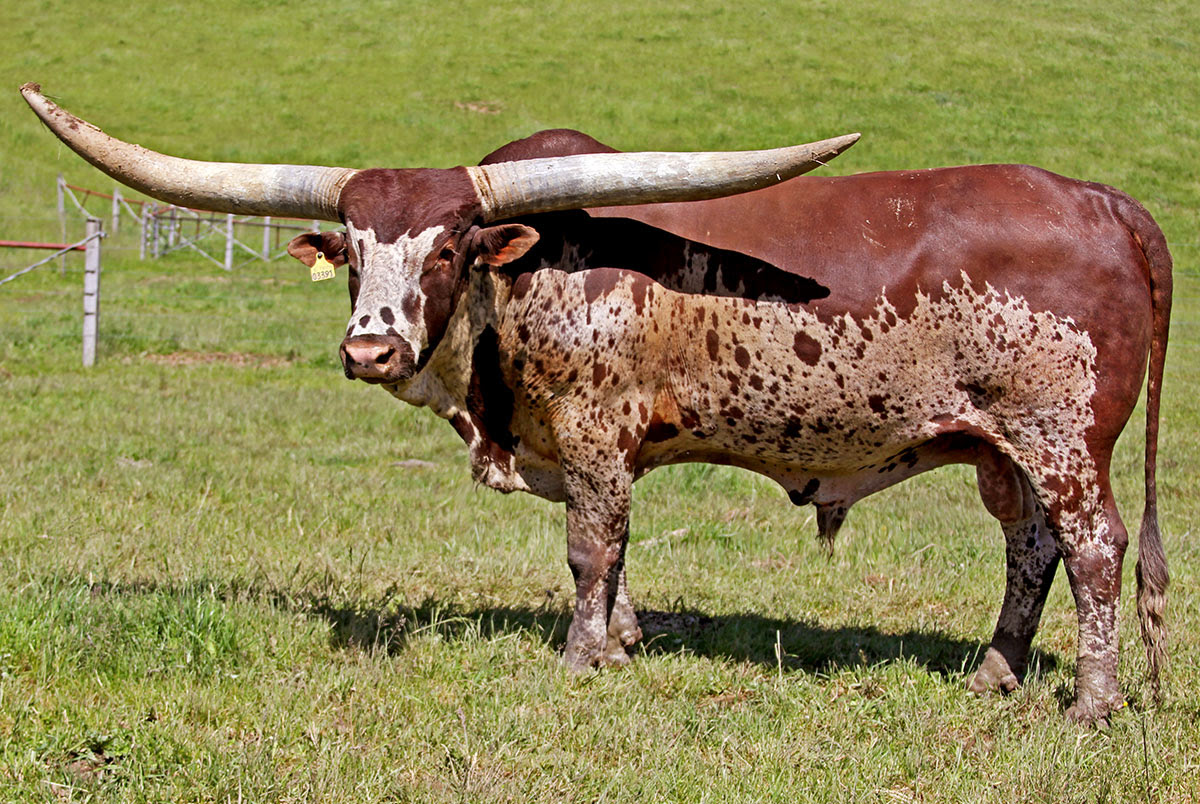Paul Powers of Asheboro, NC was appointed by the WWA Board of Directors to complete the term of Cindi Darling.
2025 Election
Nominations for 2025-26 Board of Directors positions are due July 1, 2025. The three 3-year terms available are those of Pat Burnett, Garett Judd, and Brian Sims. Anyone interested in running for the WWA Board of Directors may contact a member of the nominating committee consisting of Will Ross, Barry Retchloff, and Blake Edwards.
The Loss of a Great One
Cynthia Darling “Cindi” has been an inspiration and a dear friend to so many not just in the Watusi breed but throughout the exotic world and beyond. She began raising Watusi in the early 80’s and served on the WWA board of directors from that time until her passing this spring. Her contribution and dedication to the WWA and the Watusi breed will remain unmatched. No words can describe her importance to this association and the Watusi breed and how much she will be missed by all. Anyone who knew Cindi can tell you she was one of a kind!




Spring Meeting in Macon
The WWA Board of Directors will meet in Macon, MO at the Comfort Inn Meeting Room at 4:00 pm on April, 9 2025. The spring fling membership meeting will follow at 7:00 pm and all Watusi enthusiasts are welcome to attend. Catered meal by donation. Fun auction of donated items will benefit the WWA and the function. Anyone is welcome to come and feel free to bring items for the fun auction and any paperwork needing assistance with. For more information contact any board member.
2024 Scholarship Award
The WWA altered our Scholarship rules this year. We normally offer one annual Scholarship for $1,000.00, this year however we were faced with a difficult decision. We were presented with three very qualified individuals so thanks to the generosity of a donor we had $500.00 privately added to our fund and we choose to award three $500.00 Scholarships. Our recipients are: Brent Judd who will be attending Kentucky Auction Academy. Brent has been involved with watusi for 10 years and has participated with the breed association during that time. He hopes to acquaint more young people with the breed from his own animals and his future plans in the livestock industry through sale venues.: Nathan Lanier is presently attending Appalachian State University. He has been involved with raising and selling calves for many years and then became acquainted with the Watusi breed. He became particularly fascinated with the variety of horns. He feels that his youth is a benefit to marketing and wants to get more farmers involved.: Our third recipient is Taysia Richens, she will be attending Utah State University with a plant based agricultural major. Taysia’s family has been raising watusi all of her life so she is no new comer to the breed. She looks forward to applying her horticulture education to improving the care and maintenance of the breed itself. She has extensive experience in exhibiting, showing and promoting the breed in multiple venues and plans to continue benefiting the breed and the association.
Our Board of Director’s is very excited to see this level of enthusiasm and variety of directions these young people show. We believe that these traits are the future of our Association and the continuation of this wonderful breed.
2024 Election
The Board Positions available for the 2024 through 2025 season are open for nomination through July 1, 2024. The expiring 3 year terms of Duane Gilbert, Vernon Base and Will Ross are available. Anyone with an interest in running may contact any member of the nomination commitee, Blake Edwards, Cindi Darling or Barry Retchloff.
American Royal Watusi Show 2023
On October 7, 2023 the World Watusi Association held its second annual show at the American Royal facility in Kansas City, Missouri. Per the show venue “The American Royal began in October of 1899 as the National Hereford Show, the first nationwide show for the exposition and sale of purebred cattle.” This year was the 124th for this show venue. It was refreshing to hear a cowboy’s prayer that our animals would behave and to hear Lee Greenwood’s stunning version of our National Anthem.
The first class this show was Sr. Showmanship. Blake Edwards was awarded 1st place with Red Hill Girlie Sue a 2017 Native cow. Girlie Sue also took 1st place in the Native Female born 2018 or before class as well as earning the Grand Champion in Native Females. Blake and Girlie Sue had a great day.

Second place went to Clayton Mason with Liars Lake Reynaldo a 2022 calf. This was the first time in Showmanship for both of them.

AMERICAN ROYAL WATUSI SHOW
October 7, 2023
Animal Name Birthdate Exhibitor
Showmanship at Halter, Sr.
1st Red Hill Girlie Sue 6/15/2017 Blake Edwards
2nd Liars Lake Reynaldo 5/13/2022 Cynthia Darling
Native Females Born 2023
1st Liars Lake Shooting Star 4/26/2023 Cynthia Darling
Native Females, born 2022
1st BSCC Miss Redbud 5/29/2022 Joseph Lolli
Native Females born 2020 or 2019
1st Liars Lake PITA 6/2/2019 Cynthia Darling
Native Females born 2018 or before
1st Red Hill Girlie Sue 6/15/2017 Blake Edwards
2nd Liars Lake Starmist 5/16/2018 Cynthia Darling
Grand Champion Native Female Red Hill Girlie Sue
Reserve Champion Native Female Liars Lake PITA
Foundation Pure Females born 2023
1st Red Hill Megavolt 4/27/2023 Blake Edwards
2nd BSCC Lady Teardrop 7/15/2023 Brian Sims
3rd RRR Rosa Roja 1/14/2023 Barry Retchloff
4th Liars Lake Hamu 6/28/2023 Cynthia Darling
Foundation Pure Females born 2022
1st BSCC Moon Shadow 5/16/2022 Brian Sims
2nd MR Valentina 1/28/2022 Brian Sims
3rd Red Hill Tempest Storm 4/26/2022 Blake Edwards
4th BSCC Crimson Queen 6/09/2022 Joseph Lolli
5th Liars Lake Hyacinth 5/05/2022 Cynthia Darling
Foundation Pure Females born 2021
1st Red Hill Dolly Blaze 5/22/2021 Blake Edwards
2nd Liars Lake Storm Front 6/22/2021 Cynthia Darling
Foundation Pure Females born 2020 or 2019
1st Red Hill Too-Far-Rae 6/08/2019 Blake Edwards
2nd RGR Lucky Lady 5/23/2020 Brian Sims
3rd Liars Lake Azelea 6/1/2019 Cynthia Darling
4th RRR Brittney 5/23/2020 Barry Retchloff
Foundation Pure Females born in 2018 or before
1st Red Hill Kilavolt 6/20/2018 Blake Edwards
2nd BSCC Red Red Wine 4/23/2017 Brian Sims
3rd Liars Lake Hottie 6//14/2015 Cynthia Darling
4th RRR Carolina’s Red Roan 6/15/2015 Barry Retchloff
5th Coon Creek Kianeeshi 6/13/2017 Brian Sims
Grand Champion Foundation Pure Female Red Hill Kilavolt
Reserve Champion Foundation Pure Female Red Hill Dolly Blaze
Cow/Calf Cows born I 2019 or after
1st Red Hill Too-Far-Rae 6/08/2019 Blake Edwards
2nd RGR Lucky Lady 5/23/2020 Brian Sims
3rd Liars Lake Azelea 6/1/2019 Cynthia Darling
4th RRR Brittney 5/05/2020 Barry Retchloff
Cow/Calf Cows born I 2018 or before3
1st Red Hill Kilavolt 6/20/2019 Blake Edwards
2nd BSCC Red Red Wine 4/23/2017 Brian Sims
3rd RRR Carolina’s Red Roan 6/15/2015 Barry Retchloff
4th Coon Creek Shakira 3/05/2010 Joseph Lolli
5th Liars Lake Hottie 6//14/2015 Cynthia Darling
Bulls Born 2023
1st BSCC Mavericjk 4/23/2023 Brian Sims
2nd Red Hill Rockin Uno 1/19/2023 Blake Edwards
3rd BSCC Bordeaux 4/18/2023 Brian Sims
4th Liars Lake Alfalfa 5/08/2023 Cynthia Darling
Bulls Born 2022
1st BSCC Tafari Storm 4/26/2022 Brian Sims
2nd Red Hill Hot Stepper 5/10/2022 Blake Edwards
3rd Liars Lake Rumble 5/30/2022 Cynthia Darling
Bulls Born 2201
1st Liars Lake Kakoma 8/07/2021 Cynthia Darling
2nd Diamond Black Lightning 4/12/2021 Joseph Lolli
Grand Champion Bull Red Hill Kilavolt
Steers Born 2020 or after
1st BSCC Ruger 6/19/2022 Brian Sims
2nd Liars Lake Reynaldo 5/13/2022 Cynthia Darling
Starter Herd For Sale
……..sorry all SOLD……..
Here is an opportunity to purchase a quality starter herd. These animals are located in Mississippi. The group consists of 6 heifers, 2 are percentage 4 are Foundation pure. One first calf heifer with a heifer calf and a young Foundation bull herdsire.
For further information contact seller Jon Catlett at 601-770-3717

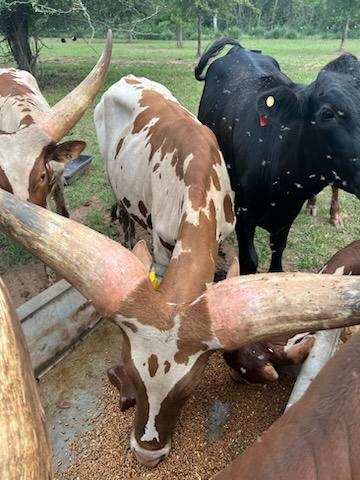
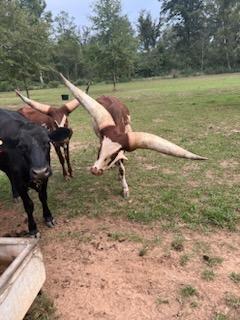

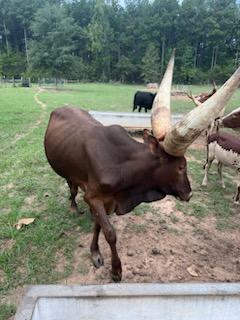

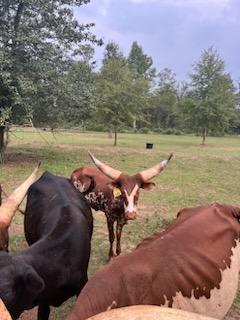
Jimmy the Swede
|
|||
Jimmy The Swede, a history
DCC e-News #330 – 10-28-23
by Darol Dickinson
Jimmy The Swede was born in a Stockholm, Sweden zoo in 1977. Him and a solid red bull were purchased by Jimmy Tarbox of Oklahoma, brought to the USA and quarantined for months in the Harry S. Truman Import Center of Florida. This process cost many thousands of dollars and only for those with great appreciation of rare genetics could afford it. It was the regulation for all zoo animals and livestock coming into the USA breeding herds. Blood was drawn monthly, all kinds of tests were run. If a resident of HST flagged any positive test, the carcass would be burned immediately. In fact every day sanitary methods of scooping fecal material and burning it was standard process. To government inspectors capable of finding bones in animal crackers—there was an hourly hunt for any infectious organisms.
 Jimmy The Swede, at DCC, in Colorado. We liked his specks, but had no clue this line of colors was a strong genetic factor originating from one animal of the 1920 African import to Europe.
Jimmy The Swede, at DCC, in Colorado. We liked his specks, but had no clue this line of colors was a strong genetic factor originating from one animal of the 1920 African import to Europe.
Jimmy Tarbox bought two bulls so in case one was government destroyed, he would have one survivor. When both bulls were clean as a meat axe, he had an extra bull. Knowing of this effort Dickinson Cattle Co (DCC) was able to lease one speckled bull for 2 years. Jimmy kept the red bull.
Once the speckled bull got to DCC in Colorado, semen was collected and he was introduced to his first Watusi and other horned cow herd. Jimmy was the first Watusi sire for frozen semen collection and was the first to sire calves by embryo transfer.
 Prior to the influence of Jimmy The Swede most North American Watusi herds were totally red or only had a few white spots. This is the Rare Animal Survival Center, a major importer, in Ocala, Florida, 1979.
Prior to the influence of Jimmy The Swede most North American Watusi herds were totally red or only had a few white spots. This is the Rare Animal Survival Center, a major importer, in Ocala, Florida, 1979.
He sired more Watusi calves than any other Watusi sire in history. His name appears in more registered Watusi pedigrees than any other bull. His signature trait is a distinct line of separation on his progeny that goes from the center of the nose, to the jaw, to the middle of the neck to the middle of the ribs and on to the middle of the hip. This line generally is dark mahogany above the line and white below with mahogany spots. Due to his singular influence about 15% of the registered Watusi in the USA carry this popular color pattern. It is the strongest genetic factor in the USA Watusi herds.
 This age 4 Watusi cow in the DCC herd traces back to Jimmy 6 generations deep. This is now called the “Swede pattern.” The word “Jimmy” came from Jimmy Tarbox and of course Sweden was the birth origin.
This age 4 Watusi cow in the DCC herd traces back to Jimmy 6 generations deep. This is now called the “Swede pattern.” The word “Jimmy” came from Jimmy Tarbox and of course Sweden was the birth origin.
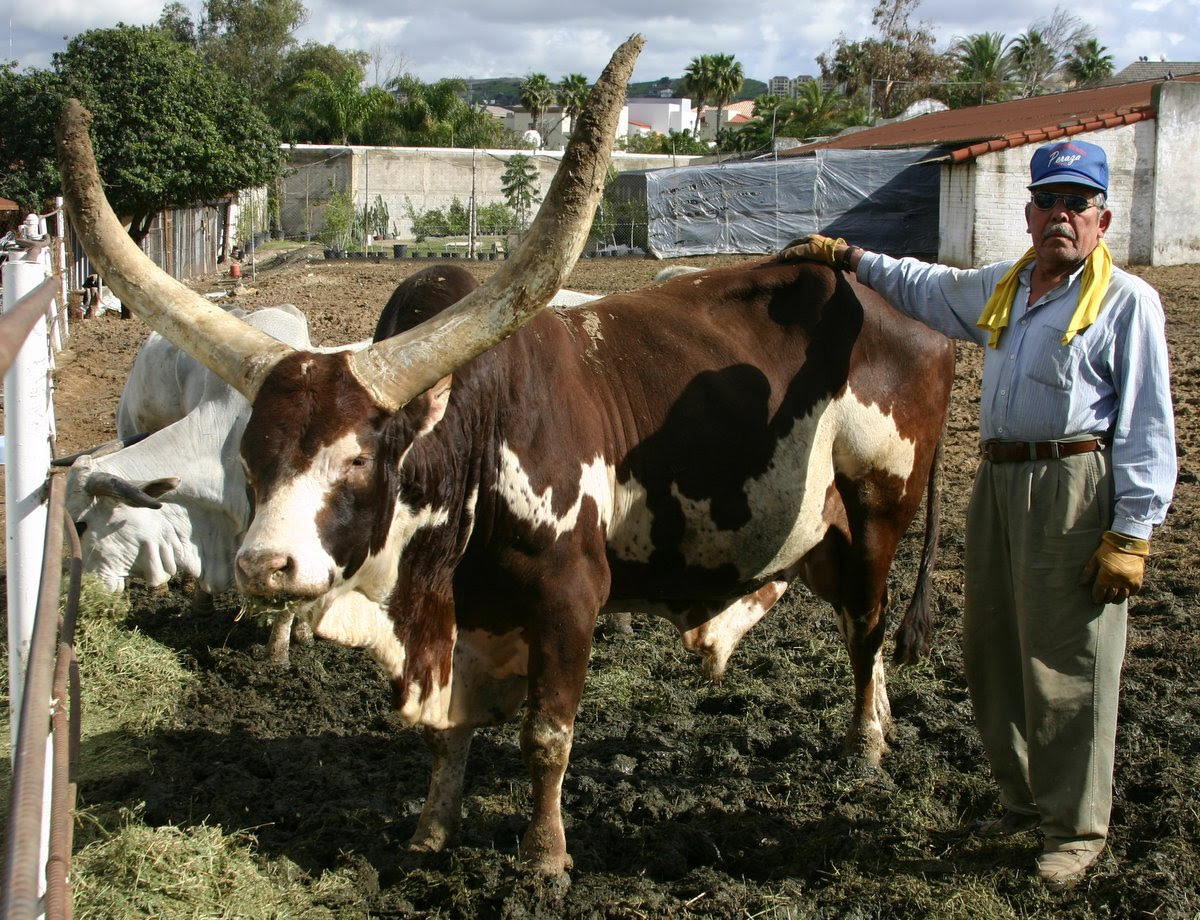 This Watusi in Mexico, although not a perfect Swede pattern, sires many progeny with perfect Swedes.
This Watusi in Mexico, although not a perfect Swede pattern, sires many progeny with perfect Swedes.
In 1984 a group of excited Watusi enthusiasts comprised of Don Zavislan
(President) of Pueblo West, Colorado; Darol Dickinson (Vice President), Calhan, Colorado; Marlin Neidhardt, Hebron, North Dakota; Peter Lang, Santa Rosa, California; Bill Lowe, Canon City, Colorado; Emmett Jones, Dobbin, Texas; and Willard Moore, Columbus, Montana became the first Board of Directors of a new organization to become known as the World Watusi Association. The Association was formed to collect records and maintain a stud book of the pedigrees for this rare and unique breed of cattle, as well as to be a promotional force for all those who love these special animals.
Although many modern Watusi who don’t have the Swede Pattern do in fact possess wild-design African white markings. The whiter spot patterns are commanding attention and top prices, many of which go back to this early foundation citizen of Sweden.
For semen from Jimmy The Swede and other well known Watusi sires
check https://www.texaslonghorn.com/
AMERICAN ROYAL WATUSI SHOW
If you are going to be in the Kansas City, Missouri area do not miss your chance to see the World Watusi Association’s 2nd annual Watusi show at the American Royal Complex, 1701 American
Royal Court, Kansas City, Missouri. The Watusi Show will be held at 2:00pm at the Hale Arena, on Saturday, October 7, 2023.


